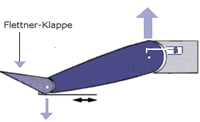Servo tab

Imagine you're riding a bike, and the pedals are the main way you can make the bike go. But sometimes, you might want to take your hands off the handlebars to, say, wave hello to someone. If you do that, the bike might start to wobble and swerve around, which isn't very safe or comfortable.
A servo tab on an airplane is kind of like the training wheels on a bike. It helps the pilot control the plane more easily and stay on a stable course, even if there's wind or turbulence.
Here's how it works: the servo tab is a small piece of metal or plastic attached to the trailing edge of the airplane's main control surface, like the elevator or rudder. When the pilot moves the control stick or pedals in the cockpit, the main control surface starts to move too. But before it can start changing the plane's direction, the servo tab moves first - but in the opposite direction!
For example, if the pilot pushes the control stick forward to make the nose go down, the elevator control surface will move downwards. But the servo tab attached to the top edge of the elevator will move upwards - this creates a small force that adds to the main control movement, making the elevator move even further downwards.
The reverse happens when the pilot pulls back on the control stick to make the nose go up. This time, the elevator control surface moves upwards, and the servo tab attached to the bottom edge of the elevator moves downwards, helping to pull the elevator up even more.
In this way, the servo tab helps the pilot fine-tune the amount of control movement needed to keep the plane flying smoothly. It also reduces the amount of pressure and effort required from the pilot's hands and feet, making it easier and less tiring to fly for long periods of time.
A servo tab on an airplane is kind of like the training wheels on a bike. It helps the pilot control the plane more easily and stay on a stable course, even if there's wind or turbulence.
Here's how it works: the servo tab is a small piece of metal or plastic attached to the trailing edge of the airplane's main control surface, like the elevator or rudder. When the pilot moves the control stick or pedals in the cockpit, the main control surface starts to move too. But before it can start changing the plane's direction, the servo tab moves first - but in the opposite direction!
For example, if the pilot pushes the control stick forward to make the nose go down, the elevator control surface will move downwards. But the servo tab attached to the top edge of the elevator will move upwards - this creates a small force that adds to the main control movement, making the elevator move even further downwards.
The reverse happens when the pilot pulls back on the control stick to make the nose go up. This time, the elevator control surface moves upwards, and the servo tab attached to the bottom edge of the elevator moves downwards, helping to pull the elevator up even more.
In this way, the servo tab helps the pilot fine-tune the amount of control movement needed to keep the plane flying smoothly. It also reduces the amount of pressure and effort required from the pilot's hands and feet, making it easier and less tiring to fly for long periods of time.
Related topics others have asked about:
